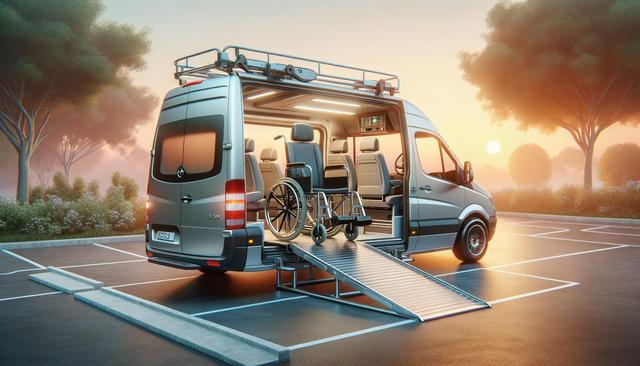Ramp Type and Accessibility Mechanism
One of the first aspects to consider when renting a wheelchair van is the type of ramp or lift mechanism it uses. Many people overlook whether the ramp is manual or automatic, and this can significantly impact ease of use and accessibility. For instance, manual ramps might require additional physical effort or assistance, which could be inconvenient for solo travelers or caregivers unfamiliar with the setup.
There are generally two main types:
- Side-entry ramps: These provide easier access in parking lots with enough side clearance and are useful for drivers or front-seat passengers in wheelchairs.
- Rear-entry ramps: These are often more affordable and better suited for passengers who sit in the back of the van.
In addition to ramp placement, check the angle and width. A steep or narrow ramp can be a safety issue, especially in poor weather conditions. Make sure the accessibility mechanism aligns with your daily needs and that you or your caregiver are comfortable operating it. Don’t hesitate to request a demonstration before finalizing the rental.
Interior Space and Seating Configuration
Another detail often missed is how much usable space is available inside the van. Some wheelchair vans may look roomy from the outside but have limited maneuverability inside, especially once a wheelchair is secured. Understanding the layout is critical for comfort and safety during travel.
Key questions to ask include:
- Is there enough space to turn the wheelchair around inside the van?
- How many additional passengers can the van seat comfortably?
- Is the wheelchair secured facing forward, backward, or sideways?
Consider who will be traveling with you. If you have a family or support team, make sure there is adequate space for everyone to sit safely without compromising the wheelchair area. Some vans offer flexible seating that can be folded away or removed entirely, which is worth investigating if your needs vary between trips.
Vehicle Height and Entry Clearance
Vehicle height and entry clearance are often overlooked until the actual time of use. If your wheelchair has a high backrest or if the user is tall, low clearance can be problematic and even lead to injury during entry or exit. Likewise, garages or parking structures with low ceilings might not accommodate taller wheelchair vans.
To avoid this issue, measure the height of the wheelchair including the user and compare it to the van’s entry clearance. Also, check whether the ramp or lift can fully deploy in tighter spaces. This is especially important for side-entry vehicles in narrow parking spots. Keep these points in mind:
- Measure both the user and chair height before booking.
- Ask for the full dimensions of the van, including interior height and door clearance.
- Consider where you’ll be parking and whether the van can easily enter and exit those areas.
These small checks can prevent major frustrations on the road or at your destination.
Insurance Coverage and Roadside Assistance
Many renters focus on the vehicle itself but forget to look into insurance coverage and roadside assistance. Wheelchair vans have specialized equipment, and not all standard policies will cover damages or malfunctions related to ramps, lifts, or tie-down systems. Understanding what is and isn’t covered can save you from unexpected costs.
When reviewing your rental agreement, be sure to:
- Ask if the rental includes comprehensive coverage for both the vehicle and the accessibility equipment.
- Check if your personal auto insurance or credit card benefits extend to specialized vehicles.
- Ensure that roadside assistance is available 24/7, especially if you’re traveling to unfamiliar areas.
Having a clear understanding of insurance and support services can give you peace of mind. If possible, opt for services that include technical support for accessibility features in case something goes wrong during your trip.
Training and Familiarization with the Van
Finally, one of the most underestimated aspects of renting a wheelchair van is the time spent getting familiar with the vehicle. These vans often come with modified controls, securement systems, and other features that aren’t found in standard vehicles. Skipping a proper orientation can lead to confusion or improper use of equipment.
Before you drive away, take time to:
- Understand how to operate the ramp or lift system safely.
- Practice securing the wheelchair using the tie-down system.
- Test drive the van in a parking lot to get used to its size and handling.
If you’re traveling with a caregiver or assistant, involve them in the training as well. Some rental providers offer instructional videos or printed guides, which can be valuable references during your trip. Investing even 30 minutes in learning the vehicle’s features can make your experience significantly smoother and safer.
Conclusion: Plan Ahead for a Safer, More Comfortable Trip
Renting a wheelchair van involves more than picking the first option that becomes available. By paying attention to ramp types, interior layout, clearance, insurance, and training, you can ensure that your trip is safe, comfortable, and stress-free. Each of these elements plays a role in how well the van meets your specific needs. A bit of extra planning before the rental can save you time and trouble later, allowing you to focus on enjoying your journey rather than dealing with unexpected obstacles.


